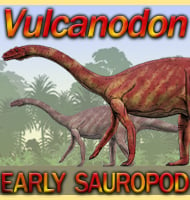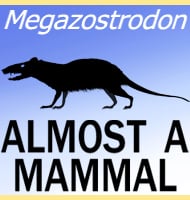In Depth
Theosodon was probably a lot like a llama in appearance, however it was not actually related to this group of mammals (the Camelidae) but instead was a litoptern mammal, the dominant group of mammals in South America before it became joined to North America. This is a case of convergent evolution where even though the animal is unrelated, it still develops similar features and appearance in order to cope with the same survival challenges. Others of this group like Diadiaphorus became more like primitive horses like Mesohippus in North America, while other forms like Macrauchenia became more like camels albeit with some unusual features. In fact Theosodon is sometimes considered as being the ancestor to Macrauchenia.
Theosodon is noted for having a narrow jaw with a full complement of forty-four teeth, the maximum number that are known for placental mammals, although often mammals are known to have less, especially in later more advanced forms. Like the related Macrauchenia, Theosodon might have been a generalist herbivore that both browsed vegetation and grazed grass. Although two meters long, Theosodon was within the predatory scope of marsupials like Borhyaena, but was already in decline if not gone by the time the sabre-toothed Thylacosmilus appeared. An even greater threat however would have come from large phorusrhacid terror birds like Phorusrhacos and Kelenken that would have easily had both the speed and killing power to take down an animal the size of Theosodon. It is also worth noting that the decline of Theosodon does seem to coincide with the rise of large phorusrhacids.
Further Reading
– Nuevos restos de mam�feros f�siles descubiertos por Carlos Ameghino en el Eoceno inferior de la Patagonia austral. – Especies nuevas, adiciones y correcciones [New remains of fossil mammals discovered by Carlos Ameghino in the lower Eocene of southern Patagonia. – New species, additions, and corrections]. – Revista Argentina de Historia Natural 1:289-328. – F. Ameghino – 1891. – Nuevas especies de mam�feros, cret�ceos y terciarios de la Rep�blica Argentina [New species of mammals, Cretaceous and Tertiarty, from the Argentine Republic]. Anales de la Sociedad Cientifica Argentina 56–58:1-142. – F. Ameghino – 1904. – Theosodon pozzi n. sp. El mayor theosodonte Santacruceano. Physis 326-327. – L. Kraglievich & L. J. Parodi – 1931. – Taxonomic Reinterpretation of Theosodon hystatus Cabrera and Kraglievich, 1931 (Litopterna, Macraucheniidae) and Phylogenetic Relationships of the Family. – Journal of Vertebrate Paleontology. 34 (5): 1231–1238. – Gabriela I. Schmidt & Brenda S. Ferrero – 2014. – Two new macraucheniids (Mammalia: Litopterna) from the late middle Miocene (Laventan South American Land Mammal Age) of Quebrada Honda, Bolivia. – Journal of Vertebrate Paleontology 38(3):e1461632. – A. J. McGrath, F. Anaya & D. A. Croft – 2018.









